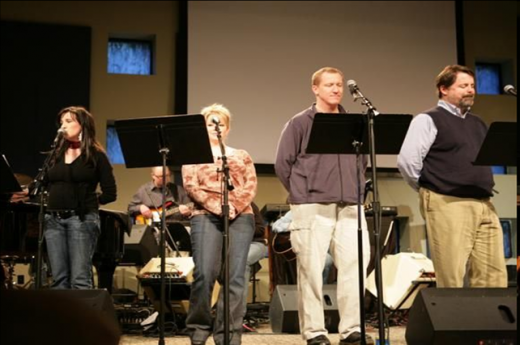- Home
- Products
- Sound Tech and PA
- Sound Tech DVDs & Downloads
- Free Tech Resources
- Free Sound Tech Lessons
- Playing By Ear
- Play By Ear DVDs & Downloads
- Ear Training & Music Theory Resources
- Worship Leading
- Worship Leading Course Downloads
- Free Worship Leader Training
- Free Worship Leader Resources
- Worship Band Skills
- Band Skills DVDs & Downloads
- DIY Worship Team Workshops
- Free Worship Team Training
- Free Worship Team Resources
Ask the Expert – How do I get my singers away from needing sheet music? (Part 2)
We featured a recent email from Julie Meyer asking about how to wean her background vocalists off of sheet music. Andy wrote a lengthy reply on the assumption that they were all glued to lyrics rather than words. Julie has now clarifed that in fact her vocalists are not only reliant upon the music for the lyrics, but also for their harmony and/or melody lines. She have been serving with most of them for over a year, and was hoping that by this time they would be moving towards just having lyric sheets, and not full SATB (Soprano, Alto, Tenor, Bass) scores of music. But some of her singers are older and have had to adjust to a lot. She’s trying not to push them, but to lead them to a more full understanding of worship.
Here’s Andy’s response to the newly clarified problem:
If they are using SATB scores then perhaps it comes back to looking at what type of music you use and type of expression you are trying to create. For instance if you are using a full choir with traditional hymns and crafted arrangements I actually see nothing wrong with using the SATB score at all. Maybe just get them to practice reading ahead, so they pre-empt the next line and have time to look up, be aware of what is going on around them, take in the meaning in the words, and generally learn to create some space for them to actively focus on God in the context of the music.
Actually this is what I’d say to most instrumentalists regardless of style or genre. What you are wanting is basically the transition from being a technician of your instrument (or voice) and only being aware of your own part into becoming a musician (singers are very much included in this phrase) who is much more aware of the other parts and contributions around them.
If, however you are working with more modern pop or just less formally structured worship style arrangements I would suggest they begin to work on starting to identify the basic harmonies by ear, rather than from the score.
As a first step you’ll need to get them to practice hearing and recalling 3rds and 5ths above and below the melody line. It takes a bit of practice but once singers get used to hearing those intervals they should be a able to work out a starting point and learn to sing in that zone. If you can get your singers to identify these, you’ll effectively have four separate harmony parts that can be used on the fly, without standard notation. The key thing is that each singer HAS to remember to stay in that range and not cross over into someone else’s part. I.e. if you are singing a 3rd above then stick with it, even if it pushes your natural range! So if you are thinking of moving towards pure lyric sheets then make sure your background vocalists understand harmony construction or they’ll probably all gravitate towards singing the melody all the time. In which case you need to ask yourself how many backing vocalists you really need and what role they actually fulfil.
Obviously this is a whole new skill and initially may require even more attention than is needed for reading the score, thus defeating for your reason for wanting to get them away from the music in the first place! This could be a big ask, especially for anyone less musical, more traditional, etc etc. So pick your battles well. If you need some more formalized help then we’ve just realised a new DVD set for learning to sing harmonies on the fly and the many other necessary skills to understand the art of backing vocals.
Other posts you may find helpful:


 Free Band Skills course with all Musicademy or Worship Backing Band DVD orders
Free Band Skills course with all Musicademy or Worship Backing Band DVD orders  Free gift with all Musicademy and Worship Backing Band DVD orders
Free gift with all Musicademy and Worship Backing Band DVD orders  Worship Training Day Ealing London 5 November 2022
Worship Training Day Ealing London 5 November 2022  How to get maximum exposure for your song writing
How to get maximum exposure for your song writing  Streaming online church services: the tech, the tips and the stories from around the world
Streaming online church services: the tech, the tips and the stories from around the world  What do you most struggle with as a worship musician?
What do you most struggle with as a worship musician?  Worship Leader Training: Beginning and Ending Songs Well
Worship Leader Training: Beginning and Ending Songs Well  Learn how to play by ear
Learn how to play by ear  4 tips for making good use of your mic
4 tips for making good use of your mic 

